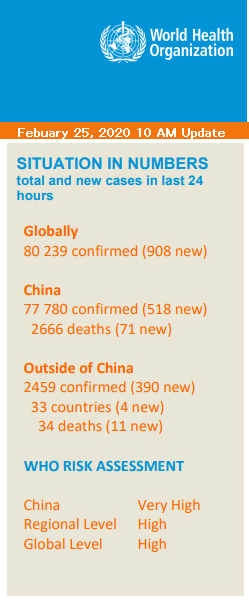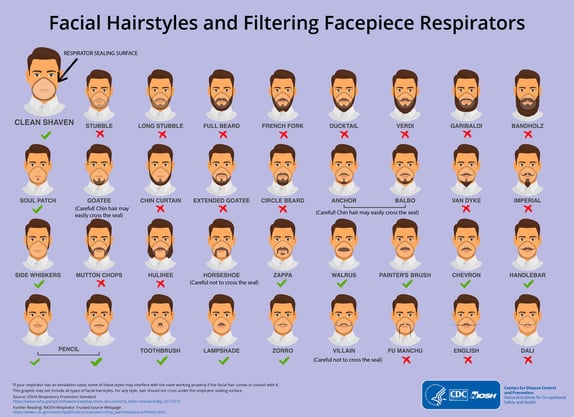Over the past month, Flagship has been providing you up-to-date information about the novel coronavirus (COVID-19). There’s information about precautions you can take, why it’s important to communicate with employees, how it’s affecting businesses globally and ways to make sure that your facility conducts cleaning regimens that will reduce your chances for infection from all viruses, including the flu and COVID-19.

On February 25, Nancy Messonnier, director of the National Center for Immunization and Respiratory Diseases at the Centers for Disease Control and Prevention, called for businesses, schools and communities to brace themselves and plan for potential outbreaks. The agency expects a sustained transmission of the virus, a wider spread of the coronavirus in the U.S. and is preparing for a potential global pandemic.
So far, American public-health systems have sought to contain the virus by isolating confirmed cases while monitoring close contacts of these patients for signs of infection. This strategy has been effective because the case count is relatively low. If the virus spreads widely, it will be impossible to contain it the same way.
The Washington Post reported, on February 19, a Northern California woman suffering from severe flu symptoms was hospitalized. On Feb 24, she tested positive for the coronavirus. She was not tested earlier because she had not traveled nor had contact with anyone known to have the infection. The state of CA is calling it the first instance of community transmission. Due to her situation, and the time it took to detect she was infected, now all staff members from two hospitals are being monitored for their safety.
As the contagion spreads, it will cause communities to begin self-quarantine strategies, such as closing business buildings and schools, canceling large functions and gatherings and instituting work from home policies when possible.
Since, at this time, there are no specific treatments for COVID-19, you should focus on prevention, for your business, employees and your facility. You should also communicate best practices to employees so they can keep themselves and their loved ones safe and healthy.
Update Your Business Continuity Plan (BCP) and Run a BCP Drill
If your organization does not have a BCP, this is the best time to create one and put the process in motion. If it hasn’t been updated in a while, this is a good time to do that as well. Make sure everyone knows their roles, what to do if they are needed and where they fall in the plan hierarchy. Take this time to run a test scenario, or a BCP drill, to find any issues so they can be fixed beforehand. Should the virus make its way into your facility, having a strong BCP can mean the difference between sealing your facility doors for a certain amount of time and shutting down your business.
You can find more information about designing a BCP at the Department of Homeland Security.
Update Your Work from Home Policy
Remote work has become very popular at most organizations, depending on your type of business. The benefits of flexible work models can increase productivity and improve employee retention. It can also be a benefit that comes to the rescue in the times of a pandemic. Should employees need to self-quarantine themselves due to symptoms or potential contamination, most of the work can continue because you have a work from home policy.
For additional advice, the Society of Human Resource Management (SHRM) offers tips on creating and managing an effective policy.
Provide enough time for employees to learn and test out the VPN and your systems. Make sure there aren’t issues with bandwidth, connectivity or compliance. It helps employees learn what to do, determine what they need at home and how they need their home office set up. It also gives your IT department time to manage coding qualifications, information security training and compliance standard updates.
Confirm Your Chemical Disinfection
According to the CDC, COVID-19 can spread from person-person (6 foot radius) via respiratory droplets, or through infected surfaces or objects. Coronaviruses can remain infectious on inanimate surfaces, such as tables and door handles (and many other high-touch surfaces) depending on the material and the conditions, for up to 9 days. This is why China’s central bank is cleaning and/or destroying its cash and eliminating possibly contaminated currency.
While the virus has the potential for a long, active, infectious life – the persistent virus is susceptible to certain sanitation agents.
The best agents to inactivate a coronavirus is a mixture including hydrogen peroxide, ethanol, and sodium hypochlorite (a chemical in bleach). It has been found to quickly (within 1-2 minutes of saturation) to successfully disinfect surfaces.

Please note that solutions of a biocide called benzalkonium chloride produced conflicting results; and chlorhexidine digluconate, which people use as a topical antiseptic, was ineffective.
Performing these disinfection techniques one or more times a day along with consistent individual handwashing can reduce the chances for transmission within facilities.
Reduce High Touch Points
During the SARS coronavirus outbreak, installing no-touch hand wash stations was the only infection control measure which was significantly associated with the protection of healthcare workers in emergency departments.
SMART technology like automated doors, touchless faucets, self-flushing toilets, self-dispensing soap and paper towels, motion detecting lights, etc. will help reduce the number of touchpoints at your facility. These items can help limit the contagion by reducing the places a virus can transmit from one person to another via surface contamination.
Robotic sprayers have been deployed in China using hypochlorite disinfectant spray or emit ultraviolet rays to disinfect hospitals and clinics. They remove the human element from the equation and allow for a full saturation of disinfectant and sanitization without risk of exposure.
Communicate with employees and get them involved
It takes everyone working together to have consistently successful prevention techniques and transmission reduction systems. You also want to calm employees’ fears and show that you are planning ahead with their safety and welfare in mind.

Talk to employees to let them know what steps you are taking to increase disinfection at the facility. Get them involved, encourage a clean desk/area policy so all surfaces can be sterilized thoroughly and encourage them to complete additional disinfection wipe downs of their areas themselves.
If your employees work directly with customers, encourage latex gloves during transactions for their safety. Post information about the importance of handwashing and proper handwashing procedures. You can download posters from the WHO.
The CDC reports that there have been 29 million people that have become ill with the flu this year, leading to 280,000 hospitalizations and 16,000 deaths. From the end of December to February 25, over 80,000 people have been infected with COVID-19 and there have been 2,666 deaths.
Many people fear COVID-19 because of its long lifespan outside of a host, the high risk for infection and its much higher mortality rate than the seasonal flu. These disinfection techniques and plans can help your business plan for any virus outbreak and will make your facility stronger, safer, cleaner and help your employees stay healthier.
For healthcare workers and public health professionals, WHO has an online course titled Infection Prevention and Control (IPC) for Novel Coronavirus (COVID-19). You can access the course through the Open WHO Website. This course provides information on what facilities should be doing to prepare to respond to a case of an emerging respiratory virus such as the novel coronavirus.





Leave a Comment